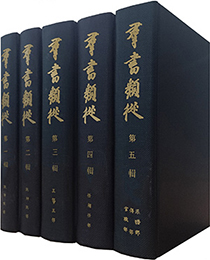JapanKnowledge

Major library of Japanese classical culture, classified by field. The entire catalog, of 3,750 titles in 133 volumes, is fully searchable in modern script.
The Gunsho Ruiju series is a major collection of manuscripts from ancient times through to the end of the early modern periods compiled under categories covering history, literature, religion, language, customs, art, music, cultivated arts, education, morality, legal codes, politics, economy, society and many other subjects.
The collection uses the latest editions of the original compilations (Gunsho Ruiju and Zoku Gunsho Ruiju 3rd edition 5th printing, and Zoku zoku Gunsho Ruiju 3rd printing), with a full-text search function using contemporary shinjitai kanji forms. Also, text images of the original collections can be viewed in high resolution and are downloadable for printing.
Bibliographical information for each source includes category, title of digitized text, authorship, content (year of transcription, source reprint details).
Many textual sources are only available in this collection, and its contribution to the comprehensive research of classical Japanese culture is expected to be significant.
The collection uses the latest editions of the original compilations (Gunsho Ruiju and Zoku Gunsho Ruiju 3rd edition 5th printing, and Zoku zoku Gunsho Ruiju 3rd printing), with a full-text search function using contemporary shinjitai kanji forms. Also, text images of the original collections can be viewed in high resolution and are downloadable for printing.
Bibliographical information for each source includes category, title of digitized text, authorship, content (year of transcription, source reprint details).
Many textual sources are only available in this collection, and its contribution to the comprehensive research of classical Japanese culture is expected to be significant.
Gunsho Ruiju / Zoku Gunsho Ruiju
Compiled and edited by Hanawa Hokiichi (1746-1821), these collections are considered foundational and important for study. Gunsho Ruiju holds 1,276 sources and Zoku Gunsho Ruiju contains 2,128. Hanawa’s search was comprehensive, categorizing and focusing on scattered and rare documents from ancient to early modern periods, covering topics on legal codes, politics, economy, education, morality, religion, society, history, literature, art, music, language, customs, cultivated arts and many more. Publication of the Gunsho Ruiju (1934) and Zoku Gunsho Ruiju (1972) was completed by the Zoku Gunsho Ruiju Kanseikai (Association for Completion of Gunsho Ruiju).
Zoku zoku Gunsho Ruiju
Published around 1907 (Meiji 40) by Kokusho Kankokai the content is divided into 10 sections using Hanawa Hokiichi’s original categorizations in his original Gunsho Ruiju and Zoku Gunsho Ruiju of ritual systems, biographies, records, legal institutions, geography, education, religion, poetry and prose, waka/tanka, miscellany. It holds many new additions not found in the earlier collections, of classical texts, old records, and classical studies written and edited in the Edo period. These number approximately 350 books considered important and necessary for various research fields, many are only found in print form in this collection. A collection totaling 17 volumes, which includes an appended volume (miscellany) by the Zoku Gunsho Ruiju Kanseikai containing an edition published by the Kosho Hozonkai (Old Book Preservation Society).
Compiled and edited by Hanawa Hokiichi (1746-1821), these collections are considered foundational and important for study. Gunsho Ruiju holds 1,276 sources and Zoku Gunsho Ruiju contains 2,128. Hanawa’s search was comprehensive, categorizing and focusing on scattered and rare documents from ancient to early modern periods, covering topics on legal codes, politics, economy, education, morality, religion, society, history, literature, art, music, language, customs, cultivated arts and many more. Publication of the Gunsho Ruiju (1934) and Zoku Gunsho Ruiju (1972) was completed by the Zoku Gunsho Ruiju Kanseikai (Association for Completion of Gunsho Ruiju).
Zoku zoku Gunsho Ruiju
Published around 1907 (Meiji 40) by Kokusho Kankokai the content is divided into 10 sections using Hanawa Hokiichi’s original categorizations in his original Gunsho Ruiju and Zoku Gunsho Ruiju of ritual systems, biographies, records, legal institutions, geography, education, religion, poetry and prose, waka/tanka, miscellany. It holds many new additions not found in the earlier collections, of classical texts, old records, and classical studies written and edited in the Edo period. These number approximately 350 books considered important and necessary for various research fields, many are only found in print form in this collection. A collection totaling 17 volumes, which includes an appended volume (miscellany) by the Zoku Gunsho Ruiju Kanseikai containing an edition published by the Kosho Hozonkai (Old Book Preservation Society).
Contents information
| Original books | 群書類従:続群書類従完成会版 訂正3版5刷~9刷 続群書類従:続群書類従完成会版 訂正3版6刷~9刷 続々群書類従:続群書類従完成会版 3刷 |
|---|---|
| Publisher | [Editing & publication] Yagi Shoten |
| Publication date |
Gunsho Ruiju: 1983 - 2002 Zoku Gunsho Ruiju: 1975 - 2000 Zoku zoku Gunsho Ruiju: 1978 |
| Number of volumes | 133 volumes |
| Book price | ― |
| Release date | October 1, 2014 |
| Number of entries | 3,750 contents; 75,300 pages |
| Number of characters | 46,457,000 characters |
| About search | Advanced Search and Bookshelves features available |
| Frequency of update | ― |
| Available services |
(as of October 2014)